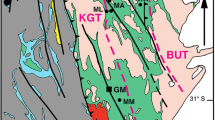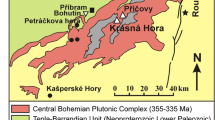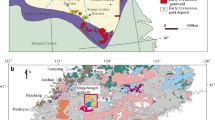Abstract
The Golden Mile deposit (1767 t Au) in the Archean Yilgarn Craton, Western Australia, is controlled by D2 strike-slip and D3 reverse faults displacing folded tholeiitic greenstones. Granodiorite and monzodiorite dykes emplaced into the faults predate and are synchronous with propylitic and sericite–ankerite alteration overprinted by the ore. Arsenopyrite and chlorite thermometry and fluid-inclusion data indicate ore formation at 420 ± 30 °C and 300 MPa and cooling to the ambient temperature at 10 km depth (250–300 °C). Fimiston refractory ore (7 g/t Au) in propylitic Golden Mile Dolerite is zoned from inner albite–ankerite to outer ankerite–phengite–quartz replacement. Pyrite–magnetite is overprinted by pyrite–hematite ± anhydrite. Arsenical pyrite encloses chalcopyrite, tennantite, gold and tellurides. Gold thio-sulfide complexes, buffered by magmatic SO2 and H2S in the fluid, were destabilised during the ankerite–pyrite replacement of propylitic chlorite, a reaction releasing hydrogen ions for the hydrolitic alteration of adjacent albite. Gold deposition was assisted by declining gold, silver, tellurium and sulfur solubility as the fluid cooled. Dissolved sulfate is recorded in pyrite by negative δ34S (− 10 to − 5‰) at magmatic Δ33S (0–0.2‰). Oroya ore bodies are subdivided into oxidised pyrite lodes (5 g/t Au) in propylitic GMD and reduced lodes (30–120 g/t Au) characterised by Stage 1 silica–pyrite and siderite–chlorite replacement in ankerite-rich wall rocks. Rapid cooling, an acidic fluid and the retrograde solubility of ankerite facilitated replacement and the deposition of minor arsenopyrite, pyrrhotite, chalcopyrite, sphalerite and gold. Locally, the H2S-rich fluid (log fS2 = − 5.8 ± 0.5 bar at 420 °C) was reduced by organic methane. Oroya Stage 2 ore fills crosscutting veins and cements breccia. Quartz, chalcedony, dolomite–ankerite, calcite, V-muscovite, V-chlorite and V-tourmaline form the gangue of pyrite–telluride ± magnetite ore. Altaite–tellurium myrmekites were deposited at ≥ 400 °C as melt droplets together with tellurantimony, altaite, calaverite, montbrayite and petzite. As fluid temperature and tellurium fugacity declined, free gold, krennerite, coloradoite and melonite also crystallised joined by sylvanite and hessite below 350 °C. Finally, trace covellite and digenite precipitated at high fluid sulfidation states.














Similar content being viewed by others
References
Afifi AM, Kelly WC, Essene EJ (1988a) Phase relations among tellurides, sulphides and oxides: I. Thermochemical data and calculated equilibria. Econ Geol 83:377–394
Afifi AM, Kelly WC, Essene EJ (1988b) Phase relations among tellurides, sulphides and oxides: II. Applications to telluride-bearing ore deposits. Econ Geol 83:395–404
Akinfiev NN, Zotov AV (2001) Thermodynamic description of chloride, hydrosulfide and hydroxo complexes of Ag (I), Cu (I) and Au (I) at temperatures of 25-500°C and pressures of 1-2000 bar. Geochem Int 39:990–1006
Akinfiev NN, Zotov AV (2010) Thermodynamic description of aqueous species in the system Cu-Ag-Au-S-O-H at temperatures of 0-600°C and pressures of 1-3000 bar. Geochem Int 48:714–720
Baker G (1958) Tellurides and selenides in the Phantom Lodes, Great Boulder mine, Kalgoorlie. Australasian Inst Min Metall, Melbourne, Stillwell Anniversary Volume, pp 15-40
Barton PB, Skinner BJ (1979) Sulfide mineral stabilities. In: Barnes HL (ed) Geochemistry of hydrothermal ore deposits, 2nd edn. Wiley, New York, pp 278–403
Barton MD, Seedorff E, Ilchik RP, Ghidotti G (1997) Contrasting siliceous replacement mineralization, east-central Nevada. In: Vikre P, Thompson TB, Bettles K, Christensen O, Parratt R (eds) Carlin-type gold deposits field conference. SEG guidebook series, vol. 28, pp. 131–134
Bartram GD, McCall GJH (1971) Wall-rock alteration associated with auriferous lodes in the Golden Mile, Kalgoorlie. In: Glover JE (ed) Symposium on Archaean rocks. Geol Soc Australia, Publ 3, pp 191–199
Bath LB, Walshe JL, Cloutier J, Verrall M, Cleverley JS, Pownceby MI, Macrae CM, Wilson NC, Tunjic J, Nortje GS, Robinson P (2013) Biotite and apatite as tools for tracking pathways of oxidized fluids in the Archean East Repulse gold deposit, Australia. Econ Geol 108:667–690
Bindi L, Paar WH, Lepore GO (2018) Montbrayite, (Au,Ag, Sb,Pb,Bi)23(Te,Sb,Pb,Bi)38, from the Robb-Montbray mine, Montbray, Quebec: crystal structure and revision of the chemical formula. Can Mineral 56:129–142
Bowles JFW, Howie RA, Vaughan DJ, Zussman J (2011) Rock-forming minerals, non-silicates: oxides, hydroxides and sulphides, 2nd edn, vol 5A. The Geological Society, London
Braun E, Raith M (1985) Fe-Ti-oxides in metamorphic basites from the Eastern Alps, Austria: a contribution to the formation of solid solutions of natural Fe-Ti-oxide assemblages. Contrib Mineral Petrol 90:199–213
Brugger J, Etschmann B, Grundler P, Liu W, Testemale D, Pring A (2012) XAS evidence for the stability of polytellurides in hydrothermal fluids up to 599°C, 800 bar. Am Mineral 97:1519–1522
Bucher K, Frey M (2002) Petrogenesis of metamorphic rocks, 7th edn. Springer, Berlin, 341 pp
Cabri LJ (1965) Phase relations in the Au-Ag-Te system and their mineralogical significance. Econ Geol 60:1569–1606
Cathelineau M (1988) Cation site occupancy in chlorites and illites as a function of temperature. Clay Miner 23:471–485
Chang LLY, Howie RA, Zussman J (1998) Non-silicates: sulphates, carbonates, phosphates, halides. In: Rock-forming minerals, 5B, 2nd edn. The Geological Society, London
Clout JMF (1989) Structural and isotopic studies of the Golden Mile gold-telluride deposit, Kalgoorlie, Western Australia. Dissertation, Monash University, Clayton, 352 pp
Clout JMF, Cleghorn JH, Eaton PC (1990) Geology of the Kalgoorlie goldfield. In: Hughes FE (ed) Geology of the mineral deposits of Australia and Papua New Guinea. Melbourne, Australasian Inst Min Metall, Monograph 14, pp 411–431
Deer WA, Howie RA, Zussman J (1992) An introduction to the rock-forming minerals, 2nd edn. Longman House, Burnt Mill
Dick JM (2008) Calculation of the relative metastabilities of proteins using the CHNOSZ software package. Geochem Trans 9:17
Einaudi MT, Hedenquist JW, Inan EE (2003) Sulfidation state of fluids in active and extinct hydrothermal systems: transitions from porphyry to epithermal environments. SEG Special Publ 10:285–313
Evans KA, Phillips GN, Powell R (2006) Rock-buffering of auriferous fluids in altered rocks associated with the Golden Mile-style mineralization, Kalgoorlie Gold Field, Western Australia. Econ Geol 101:805-817
Fleet ME (2003) Sheet silicates: micas, rock-forming minerals, 3A. 2nd edn. The Geological Society, London
Fleming AW, Handley GA, Williams KL, Hills AL, Corbett GJ (1986) The Porgera gold deposit, Papua New Guinea. Econ Geol 81:660–680
Fournier RO (1985) The behaviour of silica in hydrothermal solutions. Rev Econ Geol 2:45–61
Gauthier L, Hagemann S, Robert F (2007) The geological setting of the Golden Mile gold deposit, Kalgoorlie, W.A. In: Bierlein FP, Knox-Robinson CM (eds) Kalgoorlie 2007, old ground, new knowledge, abstracts. Geoscience Australia, Record 2007/14, pp 181–185
Godefroy-Rodriguez M, Hagemann S, LaFlamme C, Fiorentini M (2018) The multiple sulfur isotope architecture of the Golden Mile and Mt Charlotte deposits, Western Australia. Miner Deposita online, https://doi.org/10.1007/s00126-018-0828-y, this issue
Goldfarb RJ, Baker T, Dubé B, Groves DI, Hart CJR, Gosselin P (2005) Distribution, character and genesis of gold deposits in metamorphic terranes. Econ Geol 100th Anniversary Volume, pp 407–450
Golding LY (1978) Mineralogy, geochemistry and origin of the Kalgoorlie gold deposits, Western Australia. Dissertation, The University of Melbourne, 402 pp
Golding SD, Wilson AF (1983) Geochemical and stable isotope studies of the No. 4 Lode, Kalgoorlie, Western Australia. Econ Geol 78:438–450
Golding SD, Groves DI, McNaughton NJ, Mikucki EJ, Sang JH (1990) Sulphur isotope studies. In: Ho SE, Groves DI, Bennett JM (eds) Gold deposits of the Archaean Yilgarn block, Western Australia: nature, genesis, and exploration guides. University of Western Australia, Publ 20, pp 259–262
Groves DI, Goldfarb RJ, Santosh M (2016) The conjunction of factors that lead to formation of giant gold provinces and deposits in non-arc settings. Geosci Front 7:303–314
Grundler PV, Brugger J, Etschmann BE, Helm L, Liu W, Spry PG, Tian W, Testemale D, Pring A (2013) Speciation of aqueous tellurium (IV) in hydrothermal solutions and vapours, and the role of oxidized tellurium species in Te transport and gold deposition. Geochim Cosmochim Acta 120:298–325
Gustafson JK, Miller FS (1937) Kalgoorlie geology re-interpreted. Proc Aust Inst Min Metall 106:93–125
Ho SE, Bennett JM, Cassidy KF, Hronsky JMA, Mikucki EJ, Sang JH (1990) Fluid inclusion studies. In: Ho SE, Groves DI, Bennett JM (eds) Gold deposits of the Archaean Yilgarn block, Western Australia: nature, genesis, and exploration guides. University of Western Australia, Publ 20, pp. 198–211
Holland TJB, Powell R (2000) AX—a program to calculate activities of mineral end members from chemical analyses (usually determined by electron microprobe): http://www.esc.cam.ac.uk/astaff/holland/ax.html
Holland TJB, Powell R (2011) An improved and extended internally consistent thermodynamic dataset for phases of petrological interest, involving a new equation of state for solids. J Metamorph Geol 29:333–383
International Mineralogical Association, IMA (1999) Nomenclature of the micas. Mineral Mag 63:267–279
Klein F, Bach W (2009) Fe-Ni-Co-O-S phase relations in peridotite-seawater interactions. J Petrol 50:37–59
Kretschmar U, Scott SD (1976) Phase relations involving arsenopyrite in the system Fe-As-S and their application. Can Mineral 14:364–386
Laird J (1988) Chlorites: metamorphic petrology. In: Bailey SW (ed) Hydrous phyllosilicates (exclusive micas). Rev Mineralogy 19:405–453
Lanari P, Wagner T, Vidal O (2014) A thermodynamic model for di-trioctahedral chlorite from experimental and natural data in the system MgO-FeO-Al2O3-SiO2-H2O: applications to P-T sections and geothermometry. Contrib Mineral Petrol 167:968
Lin JC, Hsieh KC, Sharma RC, Chang YA (1989) The Pb-Te (lead-tellurium) system. Bull Alloy Phase Diagr 10:340–347
Manalo PC, Imai A, Subang LL, de los Santos MC, Yanagi K, Takahashi R, NJF B (2018) Mineralization of the northwest quartz-pyrite-gold veins: implications for multiple mineralization events at Lepanto, Mankayan mineral district, northern Luzon, Philippines. Econ Geol 113:1609–1626
McPhail DC (1995) Thermodynamic properties of aqueous tellurium species between 25 and 350°C. Geochim Cosmochim Acta 59:851–866
Mei Y, Liu WH, Sherman DM, Brugger J (2014) Metal complexation and ion hydration in low density hydrothermal fluids: ab initio molecular dynamics simulation of Cu (I) and Au (I) in chloride solutions (25-1000°C, 1-5000 bar). Geochim Cosmochim Acta 131:196–212
Mikucki EJ (1998) Hydrothermal transport and depositional processes in Archean lode-gold systems: a review. Ore Geol Rev 13:307–321
Mikucki EJ, Groves DI (1990) Mineralogical constraints. In: Ho SE, Groves DI, Bennett JM (eds) Gold deposits of the Archaean Yilgarn block, Western Australia: nature, genesis, and exploration guides. University of Western Australia, Publ 20, pp. 212–220
Mikucki EJ, Ridley JR (1993) The hydrothermal fluid of Archaean lode gold deposits at different metamorphic grades: compositional constraints from ore and wallrock alteration assemblages. Miner Deposita 28:469–481
Mueller AG (1990) The nature and genesis of high- and medium-temperature Archaean gold deposits in the Yilgarn block, Western Australia, including a specific study of scheelite-bearing gold skarn deposits. Dissertation, the University of Western Australia, Perth
Mueller AG (2007) Copper-gold endoskarns and high-Mg monzodiorite-tonalite intrusions at Mt. Shea, Kalgoorlie, Australia: implications for the origin of gold-pyrite-tennantite mineralization in the Golden Mile. Miner Deposita 42:737–769
Mueller AG (2017) Structural setting of Fimiston- and Oroya-style pyrite-telluride-gold lodes, Paringa South mine, Golden Mile, Kalgoorlie: 1. Shear zone systems, porphyry dykes and deposit-scale alteration zones. Miner Deposita online, https://doi.org/10.1007/s00126-017-0747-3, this issue
Mueller AG (2018) Paragonite-chloritoid alteration in the Trafalgar Fault and Fimiston- and Oroya-style gold lodes in the Paringa South mine, Golden Mile, Kalgoorlie: 2. Muscovite-pyrite and silica-chlorite-telluride ore deposited by two superimposed hydrothermal systems. Miner Deposita online, https://doi.org/10.1007/s00126-018-0813-5, this issue
Mueller AG, Muhling JR (2019) Early pyrite and late telluride mineralization in vanadium-rich gold ore from the Oroya Shoot, Paringa South mine, Golden Mile, Kalgoorlie: 3. Ore mineralogy, Pb-Te (Au-Ag) melt inclusions, and stable isotope constraints on fluid sources. Miner Deposita online, https://doi.org/10.1007/s00126-019-00876-6, this issue
Mueller AG, Harris LB, Lungan A (1988) Structural control of greenstone-hosted gold mineralization by transcurrent shearing—a new interpretation of the Kalgoorlie mining district, Western Australia. Ore Geol Rev 3:359–387
Mueller AG, de Laeter JR, Groves DI (1991) Strontium isotope systematics of hydrothermal minerals from epigenetic Archean gold deposits in the Yilgarn block, Western Australia. Econ Geol 86:780–809
Mueller AG, Lawrance LM, Muhling J, Pooley GD (2012) Mineralogy and PTX relationships of the Archean Hannan South Au-Cu (Co-Bi) deposit, Kalgoorlie, Western Australia: thermodynamic constraints on the formation of a zoned intrusion-related skarn. Econ Geol 107:1–24
Mueller AG, Hagemann SG, McNaughton NJ (2016) Neoarchean orogenic, magmatic and hydrothermal events in the Kalgoorlie-Kambalda area, Western Australia: constraints on gold mineralization in the Boulder Lefroy-Golden Mile fault system. Miner Deposita online, https://doi.org/10.1007/s00126-016-0665-9, this issue
Muntean JL (2018) The Carlin gold system: applications to exploration in Nevada and beyond. Rev Econ Geol 20:39–88
Ohmoto H (1986) Stable isotope geochemistry of ore deposits. Rev Mineral 16:491–559
Pokrovski GS, Roux J, Ferlat G, Jonchiere R, Seitsonen AP, Vuilleumier R, Hazemann J-L (2013) Silver in geological fluids from in situ X-ray absorption spectroscopy and first-principles molecular dynamics. Geochim Cosmochim Acta 106:501–523
Qian G, Xia F, Brugger J, Skinner WM, Bei J, Chen G, Pring A (2011) Replacement of pyrrhotite by pyrite and marcasite under hydrothermal conditions up to 220°C: an experimental study of reaction textures and mechanisms. Am Mineral 96:1878–1893
Richards JP (1990) Petrology and geochemistry of alkali intrusives at the Porgera gold deposit, Papua New Guinea. J Geochem Explor 35:141–199
Richards JP, Kerrich R (1993) The Porgera gold mine, Papua New Guinea: magmatic hydrothermal to epithermal evolution of an alkali-type precious metal deposit. Econ Geol 88:1017–1052
Richards JP, Bray CJ, Channer DMD, Spooner ETM (1997) Fluid chemistry and processes at the Porgera gold deposit, Papua New Guinea. Miner Deposita 32:119–132
Robert F, Kelly WC (1987) Ore-forming fluids in Archean gold-bearing quartz veins at the Sigma mine, Abitibi greenstone belt, Quebec, Canada. Econ Geol 82:1464–1482
Ronacher E, Richards JP, Johnston MD (2000) Evidence for fluid phase separation in high-grade ore zones at the Porgera gold deposit, Papua New Guinea. Miner Deposita 35:683–688
Ronacher E, Richards JP, Villeneuve ME, Johnston MD (2002) Short life-span of the ore-forming system at the Porgera gold deposit, Papua New Guinea: laser 40Ar/39Ar dates for roscoelite, biotite, and hornblende. Miner Deposita 37:75–86
Ronacher E, Richards JP, Reed MH, Bray CJ, Spooner ETC, Adams PD (2004) Characteristics and evolution of the hydrothermal fluid in the North Zone high-grade area, Porgera gold deposits, Papua New Guinea. Econ Geol 99:843–867
Rye RO (1993) The evolution of magmatic fluids in the epithermal environment: the stable isotope perspective. Econ Geol 88:733–753
Scantlebury GM (1983) The characterization and origin of the gold lodes in and around the Brownhill Syncline, Golden Mile, Kalgoorlie, Western Australia. B.Sc. (Honours) thesis, the University of Western Australia, Perth
Scott SD (1983) Chemical behaviour of sphalerite and arsenopyrite in hydrothermal and metamorphic environments. Min Mag 47:427–435
Shackleton JM, Spry PG, Bateman R (2003) Telluride mineralogy of the Golden Mile deposit, Kalgoorlie, Western Australia. Can Mineral 41:1503–1524
Sharp ZD, Essene EJ, Kelly WC (1985) A re-examination of the arsenopyrite geothermometer: pressure considerations and applications to natural assemblages. Can Mineral 23:517–534
Shvarov YV (2008) HCh: new potentialities for the thermodynamic simulation of geochemical systems offered by Windows. Geochem Int 46:834–839
Simpson ES (1912) Detailed mineralogy of Kalgoorlie and Boulder with special reference to the ore deposits. In: Simpson ES, Gibson CG (eds) The geology and ore deposits of Kalgoorlie, East Coolgardie Goldfield, Part 1. Geol Surv Western Australia, Bulletin 42, pp 77–160
Tomich SA (1952) Some structural aspects of Kalgoorlie geology. Proc Aust Inst Min Metall 164(165):45–76
Travis GA, Woodall R, Bartram GD (1971) The geology of the Kalgoorlie Goldfield. In: Glover JE (ed) Symposium on Archaean rocks. Geol Soc Australia, Publ 3, pp 175–190
Tripp G I (2013) Stratigraphy and structure in the Neoarchaean of the Kalgoorlie district, Australia: critical controls on greenstone-hosted gold deposits. Dissertation, James Cook University, Townsville
Van Ufford AQ, Cloos M (2005) Cenozoic tectonics of New Guinea. AAPG Bull 89:119–140
Vaughn ES, Ridley JR (2014) Evidence for exsolution of Au-ore fluids from granites crystallized in the mid-crust, Archaean Louis Lake batholith, Wyoming. In: Garofalo PS, Ridley JR (eds) Gold-transporting hydrothermal fluids in the Earth’s crust. Geological Society, London, Special Publ 402
Voronin MV, Osadchii EG, Brichkina EA (2017) Thermochemical propertries of silver tellurides including empressite (AgTe) and phase diagrams for Ag-Te and Ag-Te-O. Phys Chem Miner 44:639–653
Weiland RJ, Cloos M (1996) Pliocene-Pleistocene asymmetric unroofing of the Irian fold belt, Irian Jaya, Indonesia: apatite fission-track thermochronology. GSA Bull 108:1438–1449
Wimmenauer W (1985) Petrografie der magmatischen und metamorphen Gesteine. Enke, Stuttgart
Xing YL, Etschmann B, Liu WH, Mei Y, Shvarov Y, Testemale D, Tomkins A, Brugger J (2019) The role of fluorine in hydrothermal mobilization and transportation of Fe, U and REE and the formation of IOCG deposits. Chem Geol 504:158–176
Xue Y, Campbell I, Ireland TR, Holden P, Armstrong R (2013) No mass-independent sulfur isotope fractionation in auriferous fluids supports a magmatic origin for Archean gold deposits. Geology 41:791–794
Zimmer K, Zhang YL, Lu P, Chen YY, Zhang GR, Dalkilic M, Zhu C (2016) SUPCRTBL: a revised and extended thermodynamic dataset and software package of SUPCRT92. Comput Geosci 90:97–111
Acknowledgements
The senior author is grateful to Greg Hall and Patrick Verbeek for allowing access to the Paringa South underground mine in 1986–1987; Marco Einaudi for sharing his knowledge on magmatic–hydrothermal ore deposits during post-doctoral studies at Stanford University in 1992–1994; the staff of Kalgoorlie Consolidated Gold Mines for guided tours in 2016; the Geological Survey of Western Australia for access to the Joe Lord core library in 2016 and 2019; and the staff of the Western Australian Museum for access to their mineral collection. Malcolm Roberts acknowledges the support from the Centre for Microscopy, Characterization and Analysis (CMCA) at the University of Western Australia.
Author information
Authors and Affiliations
Corresponding author
Additional information
Editorial handling: B. Lehmann
Publisher’s note
Springer Nature remains neutral with regard to jurisdictional claims in published maps and institutional affiliations.
Electronic supplementary material
ESM 1
(PDF 12546 kb)
Rights and permissions
About this article
Cite this article
Mueller, A.G., Hagemann, S.G., Brugger, J. et al. Early Fimiston and late Oroya Au–Te ore, Paringa South mine, Golden Mile, Kalgoorlie: 4. Mineralogical and thermodynamic constraints on gold deposition by magmatic fluids at 420–300 °C and 300 MPa. Miner Deposita 55, 767–796 (2020). https://doi.org/10.1007/s00126-019-00939-8
Received:
Accepted:
Published:
Issue Date:
DOI: https://doi.org/10.1007/s00126-019-00939-8




